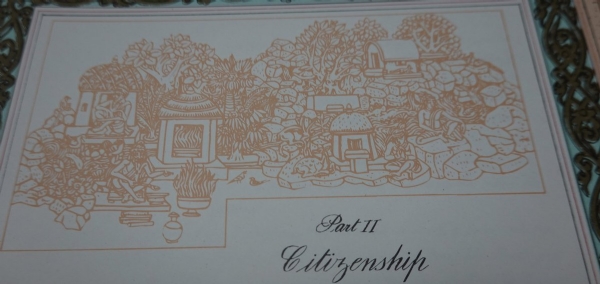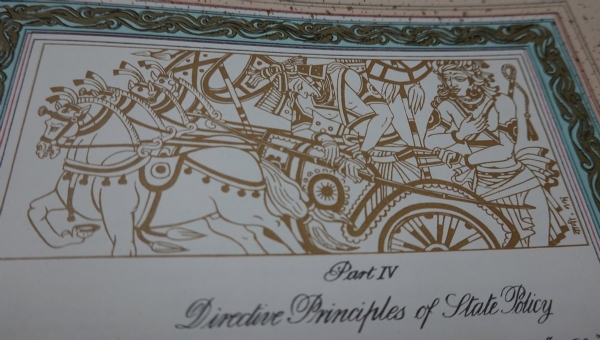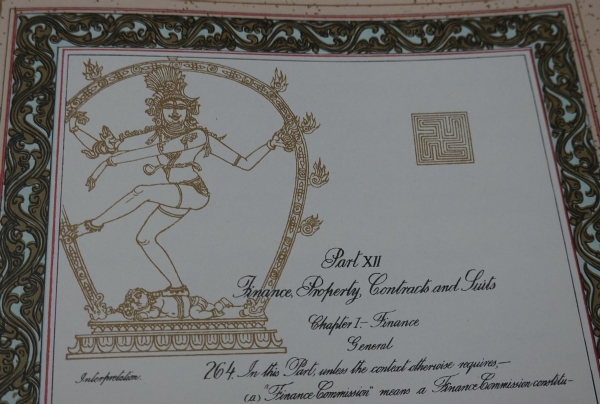Samvidhan Diwas: Historic Illustrations of Great Indian Heritage in Constitution
26 Nov 2020 13:00:48
Constitution is not merely a document but an instrument protecting rights and freedom of all sections of society and provides every citizen the right of equality without discriminating on the basis of caste, creed, sex, region, sect or language and ensures that nation remains on the path of progress and prosperity.
India possesses the world's longest written Constitution among all sovereign counties in the world. It consists of 448 articles and is divided into 25 parts. The Constitution of India is the supreme rule book that applies to every citizen of the country. Penned down by the Constituent Assembly formed in 1946, the Constitution of India was legally enforced on January 26, 1950.

In order to promote Constitution values among citizens, the Ministry of Social Justice and Empowerment notified the decision of the Government of India on 19th November 2015 to celebrate the 26th day of November every year as 'Constitution Day' or 'Samvidhan Diwas'. The Consitution that sets an example for every nation in the world. It is also a mark of tribute to Dr Bhim Rao Ambedkar, the first law minister of India, who played an important role in the framing of the Indian Constitution.
The Constitution that was neither printed nor typed was handwritten and calligraphed in both Hindi and English. The 389 member Constituent Assembly took two years, eleven months and seventeen days to complete its historic task of drafting the Constitution for Independent India. During this period, it held eleven sessions covering a total of 165 days. Of these, 114 days were spent on the consideration of the Draft Constitution. On August 29, 1947, the Constituent Assembly set up a Drafting Committee under the Chairmanship of Dr. B R Ambedkar to prepare a Draft Constitution for India.
Having said that, the members did not forget to include rich culture of India in the Samvidhan. They depicted the Indian culture through the illustrations contained in the original document. Here are some of the illustrations in the original Constitution that depict the rich cultural history of India:
1) India's vedic age

Scene from Vedic Asram (Gurukul)
In the Part II: Citizenship, it is represented by India’s Vedic Age.
2) Ramayana

Scene from the Ramayana (Conquest of Lanka and recovery of Sita by Rama)
In the Part III: Fundamental Rights, it has been depicted by an illustration of Rama, Lakshman, Sita.
3) Mahabharatha

Scene from Mahabharata (Srikrishna propounding Gita to Arjuna)
In the Part IV: Directive Principles of State Policy, it begins with the iconic scene of Arjun and Krishna’s conversation before the war.
4) Buddha

Scene from Buddha's life
In the Part V: The Union, there is the image of Buddha’s Enlightenment is lent to the part on rules related to the President and Vice President.
5) Emperor Asoka

Scene depicting the spread of Buddhism by Emperor Asoka in India and abroad
In the Part VII: The States in Part B of the First Schedule, there is an illustration depicting the spread of Buddhism by Emperor Asoka in India and abroad
6) Orissan Sculptures

Orissan Sculptures
In the Part XI: Relations between the Union and the States, there are images of Orissan Sculptures.
7) Nataraja

Image of Nataraja
In the Part XII: Finance, Property, Contracts and Suits, there is the transition phase from Ancient to Early Medieval times was marked great art again that is depicted through a render of a Nataraja Chola Bronze.
8) Chhtrapati Shivaji Maharaj and Guru Govind Singh

Portraits of Shivaji and Guru Govind Singh
In the Part XV: Elections, there are Shivaji and Guru Govind Singh portraits. Shivaji and the Sikh regime eventually weakened Mughal rule and European trade gave way to what we know as Imperial rule.
9) Netaji Subhash Chandra Bose

Netaji Subhash Chandra Bose and other patriots trying to liberate India from outside India
In the Part XIX: Miscellaneous, there is an illustration of Subhash Chandra Bose that has an artwork dedicated to him.
These are some of the illustrations depicting the Indian heritage. There are several in the Indian constitution.
Republic Day 2020: How the illustrations in the original #Constitution depict the rich cultural history of India#JaiHind #ConstitutionofIndia #RepublicDay2020 #JaiBhimIndianRepublic https://t.co/yN0DfxciVK
— Bar & Bench (@barandbench) January 26, 2020